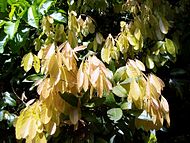en
names in breadcrumbs



Arytera is a genus of about twenty–eight species known to science, of trees and shrubs and constituting part of the plant family Sapindaceae. They grow naturally in New Guinea, Indonesia, New Caledonia, Australia, the Solomon Islands, Vanuatu, Fiji, Samoa, Tonga; and the most widespread species and type species A. littoralis grows throughout Malesia and across Southeast Asia, from NE. India, southern China, Borneo, Malaysia, Singapore, Indonesia and the Philippines to as far east as New Guinea and the Solomon Islands.
The eleven Australian species may have the common name coogera and they grow naturally in the rainforests of eastern Australia and the Northern Territory.[2][3][4][5][6]
Formerly included here were three species now in the genus Mischarytera.[7]
European science formally named and described this genus and the type species in 1847, authored by botanist Carl Ludwig Blume.[1][2][8]
In 1879 botanist Ludwig A. T. Radlkofer published formal scientific descriptions of numerous species new to European science.[9]
In 1993 botanist Hubert Turner formally described 8 species new to science found growing naturally in New Guinea, the Solomon Islands and north eastern Australia.[10] In 1994 his treatment of the genus in Flora Malesiana was published.[7][8]
This listing was sourced from the Australian Plant Name Index and Australian Plant Census,[2] the Australian Tropical Rainforest Plants information system,[11] Flora Malesiana,[8] Fruits of the Australian Tropical Rainforest,[3] the Census of Vascular Plants of Papua New Guinea,[12] the Checklist of the vascular indigenous Flora of New Caledonia,[13] Rainforest trees of Samoa,[14] Flora Vitiensis (Fiji),[15] the Flora of Tonga,[16] the Flora of New South Wales,[4] and the Flora of Australia.[5]
 Arytera divaricata colourful orange new growth
Arytera divaricata colourful orange new growth Arytera is a genus of about twenty–eight species known to science, of trees and shrubs and constituting part of the plant family Sapindaceae. They grow naturally in New Guinea, Indonesia, New Caledonia, Australia, the Solomon Islands, Vanuatu, Fiji, Samoa, Tonga; and the most widespread species and type species A. littoralis grows throughout Malesia and across Southeast Asia, from NE. India, southern China, Borneo, Malaysia, Singapore, Indonesia and the Philippines to as far east as New Guinea and the Solomon Islands.
The eleven Australian species may have the common name coogera and they grow naturally in the rainforests of eastern Australia and the Northern Territory.
Formerly included here were three species now in the genus Mischarytera.